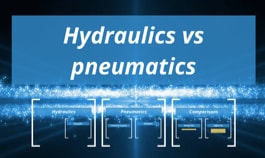I n engineering, there are different operations that require specialized equipment. Some jobs might need highly specialized and repeatable movements, while others require zero moisture for packaging foods and medical supplies.
n engineering, there are different operations that require specialized equipment. Some jobs might need highly specialized and repeatable movements, while others require zero moisture for packaging foods and medical supplies.
To handle these operations, engineers employ hydraulics and pneumatics. Now, there is a debate concerning hydraulics vs. pneumatics and which works best for specific engineering tasks. Instead of siding on either side, let’s look at what they do and in what environments would you use each.
What Are Pneumatics?
In the hydraulics vs. pneumatics debate, there are certain circumstances where you would employ one or the other. For instance, pneumatics has an advantage in wet environments, such as wash down facilities for food packaging.
To accomplish such operations, basic pneumatics use pressurized gases that trigger movement for said tasks. Pneumatics typically use interconnected components, sold by specialized vendors like SMC Pneumatics USA, to convert the compressed air to energy. Such components may include:
Gas compressor
Transition lines
Air tanks
And other components
Now, many believe the engineering tasks pneumatics perform could be classified as mundane, but there are some interesting ways to employ them, such as Disney animatronics, aircraft carrier catapults, pumpkin chucking and more.
What Are Hydraulics?
Now that we’ve talked about pneumatics, how do hydraulics work and what engineering tasks would you use them in?
Hydraulics use liquids and oils to produce mechanical energy, through properly sized components, which makes it a preferred mechanism for certain types of engineering tasks. Some of the most common uses you would see hydraulics in are: turbines, dams and rivers. These all employ some type of hydraulic mechanism for power production.
In the hydraulics vs. pneumatics debate, engineers would want to use hydraulics in work that requires very precise and often repeatable movements. This is why you would see them used in some of those named above.
Which Should You Use?
As we have stated above, there are many uses for pneumatics and hydraulics. Each has its place for engineering tasks and depending on the environment, you would choose one over the other.
A few other differences to consider would be price and pressure needed for the operation.
Pneumatics cost less, since hydraulics usually require more complex assembly and maintenance. For operations that require extremely high pressures, hydraulics would be a better choice over pneumatics.
SMC Pneumatics USA, is powered by Orange Coast Pneumatics. Orange Coast Pneumatics (OcAire) is an official, national provider of SMC Pneumatics USA products. SMC offers 11,300 general pneumatics products, with over 560,000 variations, engineered to meet applications in every sector of the market and our unique part builder allows you to create precise pneumatic components. If you would like more information on our products and services, please visit us at our Website, Facebook, Twitter, LinkedIn, and Google+.
